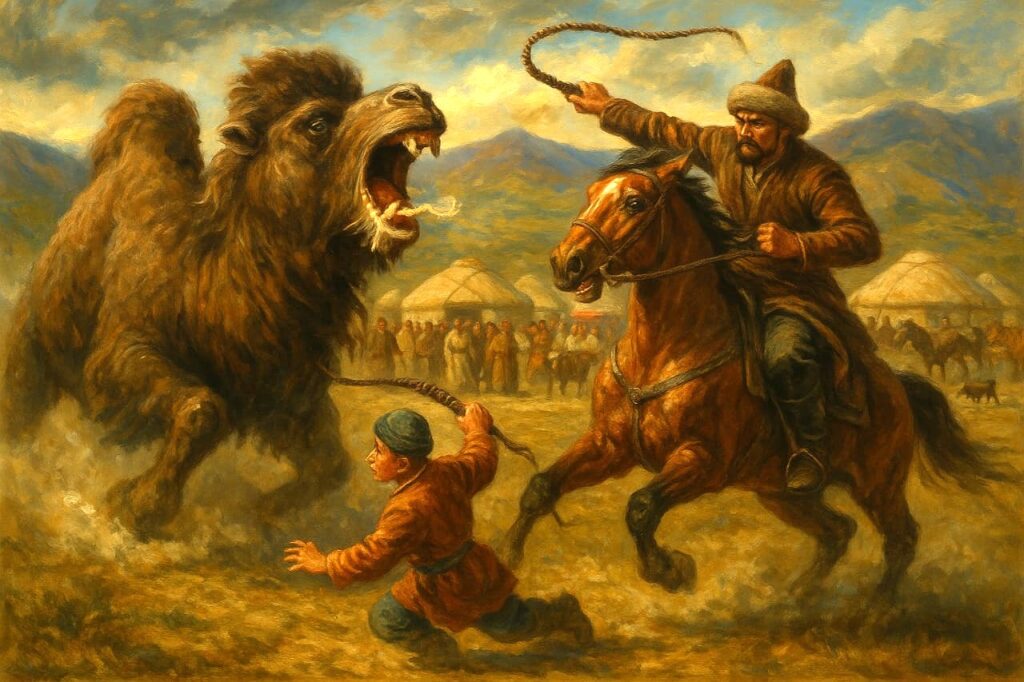© 2025. anyz.pushkinlibrary.kz All rights reserved.
Screen reader

(Recorded from Mukhtarkhan Abaganov’s words, a social activist, descendant of Kambar Tore)
In the sacred lands of Tarbagatai, on the northern slope of Mount Manyrak, there is a place known since ancient times as Kambar’s Black Gorge. This name carries the memory of a man who once shaped the fate of those who lived in this region.
But who was Kambar? What role did he play in history? Relying on old legends, we will try to uncover this mystery.
Kambar, the son of Saniyaz, was a descendant of Genghis Khan, the eighth generation after Khan Janibek. His father, Saniyaz Tore, was a contemporary of the great Abylai Khan, a ruler whose name commanded deep respect.
From a young age, Kambar proved himself as a brave warrior and a protector of his people. He accompanied his father on long campaigns, mastered the art of war, and learned the intricacies of diplomacy. While his father was alive, Kambar actively traded with China, driving thousands of livestock through the steppes and mountain passes. Later, as the leader of the Baizhigit and Tortul clans, he repeatedly displayed wisdom in resolving disputes and conflicts with neighboring tribes.
Kambar’s summer encampment was located in a gorge that would later bear his name. There, he gathered people for councils, made crucial decisions, and ensured justice.
However, over time, his power weakened, and some members of the Baizhigit clan began to challenge his authority. It was during this period that a legendary event took place.
Sarkul Batyr, the grandson of the renowned Dauletbai Batyr, was traveling to visit his relatives from the Karatai clan. As he passed by Kambar’s aul, he witnessed a terrifying scene: a massive, enraged buran (a fully grown male camel), foaming at the mouth, was chasing Kambar’s young son, ready to trample him.
Without hesitation, Sarkul grabbed his twelve-strand whip and struck the beast’s head with precise force, instantly killing it and saving the boy.
Amazed by his bravery, Kambar-Tore offered him a reward:
— Choose any animal from my herd—it is yours.
But Sarkul simply shook his head:
— I seek neither wealth nor rewards.
Kambar insisted:
— Then at least tell me what has caught your eye. If you change your mind, you may take it later.
Sarkul scanned the herds and, among all the livestock, pointed to a weak, scrawny young camel. Without saying another word, he turned his horse and rode away.
Later, Kambar asked his herders what Sarkul had chosen. When he learned that it was a sickly, malnourished camel, he fell into deep thought and finally said:
— Do you understand the meaning of his choice? He was telling us that the worth of the Tore is now no higher than that of a sick camel.
As a wise man, Kambar understood—an era was ending, and soon the people would no longer submit to him or his descendants. Realizing the coming change, he began preparing to move east to the lands of Zaysan.
Settling in Black Gorge, Kambar managed to unite various tribes and groups under his leadership, eventually forming the Saniyaz clan. Some say he even took in Russian peasants, making them dig irrigation channels from the Uidene River to cultivate millet—a shift that marked the beginning of a more settled way of life for nomadic people.
Thus, a new way of life emerged, where steppe dwellers first began embracing agriculture. Kambar lived a long life filled with trials and triumphs, but in the memory of the people, he remains a great ruler who foresaw the winds of change.
He passed away at over eighty years old. His grave lies near Zaysan, in the Manyrak Mountains, close to the Saur Ridge.
© 2025. anyz.pushkinlibrary.kz All rights reserved.
Screen reader
Write to us, we will contact you as soon as possible